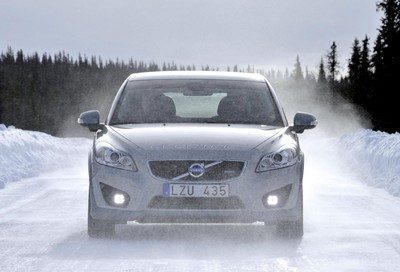Volvo C30 Electric Winter Test
Volvo is hard at work developing their first production electric vehicle based on the C30 hatchback, ad they want it to be a complete package.
That’s why parallel to efforts into making it an efficiency EV with good mileage and everything, they are paying a great attention to its safety and reliability. They recently took the car out to the cold for some serous winter testing. The car had to operate smoothly in temperatures like -20 Celsius.
Their normal cars have already done all these tests, but for the electric variant it’s a bit different because they have no previous data on how the electric parts react in extreme weather conditions. These tests determine how the batteries and all the circuits can withstand real life condition.

Volvo has developed many new ways and methods in the course of dealing with problems they came across during the EV testing. But now they can confirm their C30 is up to the job. Hoever there’s still along way ahead for the car to become fully production ready.
More details in the press release below:
The Volvo C30 Electric has been exposed to rough winter conditions in order to ensure that the battery-powered car runs smoothly in temperatures as low as -20° Celsius.
Volvo Cars’ requirements on the C30 Electric are just as stringent as on all other Volvo models and the battery-powered car is exposed to the same test regime. On top of this, several new test methods have been developed for the electric vehicles. All in all, over 200 different tests have been performed.
“We must ensure that the C30 Electric performs as intended when driving, parking and charging in a variety of conditions, from normal to very cold or hot. Northern Sweden is the perfect place to do sub-zero temperature testing,” says Lennart Stegland, director of Volvo Cars’ Special Vehicles.
The Volvo C30 Electric is equipped with three climate systems:
- One supplies the passengers with heating or cooling.
- One cools or warms the battery pack as necessary.
- The electric motor and power electronics are water-cooled.
Bio-ethanol powered heater
The C30 Electric has a innovative solution that makes it possible to get comfortable heating in cold winter conditions without compromising the battery driving range.
Climate control in the passenger compartment takes place via a bio-ethanol powered heater fitted in all cars. The car’s ethanol tank can carry 14.5 litres of bio-ethanol.
It is also possible to run the climate unit on electricity from the batteries. In electric mode an immersion heater warms up the coolant in the climate unit.
“The driver can program and control the climate unit to suit the trip. Ethanol is the default mode that is used when the battery capacity is needed for driving, extending mobility to its maximum. However, on shorter distances electricity can be used to power the climate system,” explains Lennart Stegland.




